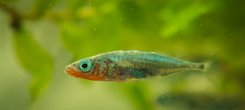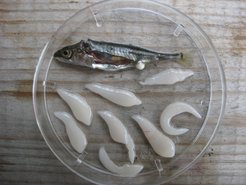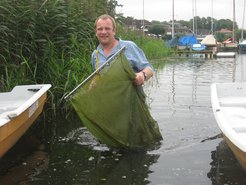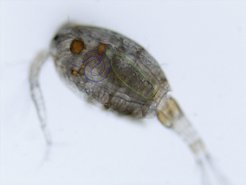A Stickleback - Full of Worms
Around 40 percent of all species on Earth are parasitic – apparently a highly successful way of life. Even a fish such as the three-spined stickleback is plagued by up to 25 different parasites. One of them particularly appealed to Martin Kalbe, Tina Henrich and Nina Hafer from the Max Planck Institute for Evolutionary Biology in Plön: the tapeworm Schistocephalus solidus. The scientists are researching the numerous tricks that host and parasite use to outdo each other.

Text: Harald Rösch
The three-spined stickleback is a cosmopolitan. Its geographic range extends across the entire northern hemisphere. Originally an inhabitant of the oceans, it probably first migrated to fresh water following the last ice age and now lives in rivers and lakes. Just as in the oceans, parasites are omnipresent in freshwater, too: roundworms, nematodes and tapeworms live at the expense of this small fish; carp lice attach themselves to its skin or in its gills and feed on its blood. Almost every part of the stickleback’s body serves as a home for one parasite or another – even its eye lenses.
Schistocephalus, then, is just one of many pests that make life difficult for the fish. Together with Tina Henrich, Martin Kalbe has been collecting sticklebacks and their worms in different regions for many years and has discovered some astounding differences. In Norway, for example, the infection rate in some populations is almost 100 percent, while in others, not a single fish is infected. The fish in Plön come in more toward the bottom end of the scale: out of 4,000 animals, only one is infested with Schistocephalus.

One of the reasons for these differences is habitat. In rivers and streams, parasites are quickly washed away by the flow of water, so they are less common there than in calmer waters. Sticklebacks that live in small, scattered populations are also less afflicted by parasites. And finally, the fishes’ predators also play a key role when it comes to the abundance of Schistocephalus, because only when the worm ends up in the right host can it complete its life cycle and produce eggs.
Initially, once the eggs have spent the winter at the bottom of a body of water, microscopically small, actively swimming larvae hatch. If they become prey and are eaten by a copepod – also known as a Cyclops because of its single eye – they continue to develop to the second larval stage. How-ever, the tiny crustacean is only the first intermediate host. Next comes the stickleback. If the latter eats the Cyclops and the larva manages to pass through the fish’s stomach without harm, it bores through the intestinal wall of the fish. The timing is important: the chances of success are greatest if the larva can develop within the crustacean for 13 to 15 days and then enter the stickleback.
The larva reaches the third larval stage in the fish’s abdominal cavity and massively increases in size and weight. Then it must wait once again until the host is eaten. This is vitally important for the Schistocephalus larva. However, it is also crucially important that it land in the right stomach. In this case, that means the digestive tract of a warm-blooded animal. As a rule, these are fish-eating birds such as herons, kingfishers and cormorants. Only at an ambient temperature of at least 38 degrees can the larvae mature into fertile worms, find a partner and mate. “In Lake Plön, for example, most sticklebacks fall victim to cold-blooded species such as perch and pike. The parasite life cycle thus ends in a cul-de-sac, which is why so few sticklebacks are infected here,” explains Henrich.
Evolutionary Arms Race

The stickleback and its worm are in a permanent competition against each other. Every advantage one of them gains is immediately countered by the other. The result is an evolutionary arms race in which the opponents permanently aim to outdo each other – like two wrestlers who have the appropriate defensive grip ready for each new attack.
The degree to which host and parasite struggle with each other is indirectly revealed when three-spined sticklebacks and Schistocephalus solidus from different areas meet: the tapeworms have even adapted to the small regional differences between the fish. Henrich and Kalbe have caught sticklebacks and their parasites in Canada, Norway and Germany and brought them together in various combinations in their laboratory in Plön. The worms are similarly infectious and grow to the same size when they have infected fish from their respective home. “Schistocephalus from Norway, however, seems to be more aggressive than its German conspecifics, because it infects fish from Lake Plön more often and grows faster in them than a German worm does in Canadian or Norwegian fish,” says Henrich.
The researchers don’t yet know why some local forms of worms are more aggressive than others, but one thing is clear: parasite and host have adapted to each other in such a way that the aggressive worms can exploit the differences between the fish populations to their benefit. And Kalbe and Henrich have gained another surprising insight: if a Norwegian worm and a German worm both infect a fish from Lake Plön, the Norwegian worm remains smaller than if it infects the fish alone. This is only to be expected – after all, it must share the nutrients. But oddly, the German worm, in contrast, grows larger than normal. The Norwegian worm seems to somehow benefit its competitor’s growth – what remains unclear is how.
Differences in adaptation also explain why Schistocephalus solidus infects exclusively the three-spined stickleback: “It has simply become so specialized in this species that it can no longer overcome the defensive strategies of other fish,” says Henrich. Those of the closely related nine-spined stickleback, for instance, which lives in the same waters as its cousin and is parasitized by Schistocephalus pungitii. Although the two tapeworms evolve only in their “own” species of fish, they can interbreed in the laboratory and produce fertile offspring. The hybrid worms that emerge from this interbreeding infest both the three- and the nine-spined stickleback. “So far, however, we haven’t discovered such hybrids in any body of water. We still don’t know why the two species don’t mix in nature even though they could,” says Henrich.
The scientists in Plön aren’t the only ones researching the arms race between the three-spined stickleback and Schistocephalus solidus. The stickleback and its tapeworm have been investigated in the laboratory since the 1960s. Today, a number of research groups worldwide use this fish and its parasite as a model system. One reason for this is that both reproduce relatively easily in the laboratory. The sticklebacks are especially easy to keep; they aren’t too demanding, and they easily lay eggs in commercially available aquariums.
Laboratory Life Cycle
As for the worm eggs, Henrich can store them in the dark for extended periods at four degrees. The larvae hatch when exposed to light. The scientist places each larva, together with a Cyclops, in the well of a laboratory cell culture plate and waits until the little copepod has picked up the parasite larva. She then feeds the infected crustacean to a stickleback.
Only the last step of the cycle deviates from its natural model, as keeping waterfowl and multiplying tapeworms in them would be too time-consuming. Instead, Henrich and her colleagues use a replacement for the bird’s intestine: a small bag of nylon gauze surrounded by a special nutrient solution. Although the bags were originally intended to hold tissue samples in medicine, Henrich must boil them in water for several hours. Only then do they cease to emit substances that are harmful to the worms. In these bags, submerged in a suitable nutrient solution at a pleasant 38 degrees, a worm couple willingly reproduces and eventually releases thousands of eggs.

Martin Kalbe collects aquatic snails, for example, to investigate their parasites.
In this way, the researchers in Plön managed to outwit the parasite and fool it into believing it was in a bird’s intestine. “It’s easier to simulate a final host than to develop an artificial intermediate host. In a bird, Schistocephalus can no longer grow, but only mate and produce eggs. Because the bird isn’t harmed by this, it hasn’t developed any defensive measures to which the worm must adapt. With the stickleback, in contrast, it has such an intimate relationship that it would be extremely difficult to reproduce it in the laboratory,” says Henrich.
Remote-Controlled Hosts
But parasites are much more than just stowaways, living at the expense of their hosts and letting them provide their meals. They must first overcome their hosts’ defense strategies. Then they frequently manipulate their hosts’ metabolism in such a way that they themselves get as many nutrients as possible. But what is most intriguing – and simultaneously most unnerving – is their ability to reprogram their hosts’ behavior. This can even go as far as an organism sacrificing its own life so that the parasite can reproduce. In such cases, the host is practically remote controlled.
“Some hosts hang on their parasites’ strings like puppets,” says Manfred Milinski, Director Emeritus of the Evolutionary Ecology Department at the Max Planck Institute in Plön since April. He has been researching the stickleback and its worms since the 1980s. “If you consider that virtually no living creature exists without parasites, you have to ask yourself what an organism’s actual behavior is and what is externally controlled.”
Not even humans are immune to manipulation from their parasites: the single-celled Toxoplasma gondii, for example, does everything it can to bring people and cats together. It needs humans as intermediate hosts to help it reach its final host, because the parasite can produce new eggs only in the intestines of predatory or domestic cats. Today, Toxoplasma is transmitted to domestic cats predominantly by mice and rats, and humans are a dead-end road for the parasite. However, when humans were still frequent prey of big cats in the early days of their development, they may have been frequent intermediate hosts for Toxoplasma gondii.
This would explain why infected individuals feel particularly attracted to cats. In order for its intermediate host to be more easily eaten by predator cats, Toxoplasma appears to reprogram the human brain so that people lose their innate caution toward all cats. According to one study, infected men find the smell of urine from domestic cats more pleasant than non-infected subjects do. The pathogen appears to have the same effect on mice and rats: while the rodents generally head straight for the next exit when they smell a cat, infected mice are even attracted to the smell of them.
Single-Celled Animal Manipulates Humans
A number of studies have now shown that Toxoplasma influences human behavior in other ways, too. According to these studies, this single-celled organism manipulates the nervous system in such a way that reaction times increase and people often defy social norms, with a possible consequence being that people infected with Toxoplasma gondii are more frequently involved in road and workplace accidents.

Cyclops and thus deliberately infected with the tapeworms
The consequences could be dramatic: “It’s estimated that more than 30 percent of the world’s population is infected, so thousands of road deaths every year may be caused by this parasite alone,” says Milinski.
Numerous cases of parasitic manipulation are now known, and many more are likely to be discovered. Another thing that remains largely unknown is how parasites manage to change the behavior of their hosts in their favor. “An infection by a parasite brings about more than just the immediate bodily reaction to it. If we can better understand how parasites manipulate their hosts, some seemingly preposterous behavior might perhaps make sense,” says Milinski.
In addition, many organisms are infested with not just one but several different parasites that affect not only the host but also each other. “In these cases, we can speak of a veritable war for control over the host,” says Milinski.
The Fight for Control
Nina Hafer from Milinski’s department investigated one such case. In Lake Plön and elsewhere, the copepods can be infested not only with the tapeworm Schistocephalus solidus, but also with a nematode known as Camallanus lacustris. Both parasites must first develop in the crustacean for some time before they can infect a fish. During this phase, the crustacean should therefore be as inconspicuous as possible to prevent it from being eaten and the parasites dying with it. But as soon as they become infectious, they profit from greater host activity.
If this development runs in parallel, all is harmonious: both worm species have the same objective and control the copepod in such a way that it is initially placid and later as active as possible. But what happens when the copepod is infected by worms at different stages of development? “Such conflicts of interest between parasites of the same or different species must be the rule in nature, but this has scarcely been investigated to date,” says Hafer.
She keeps the infected Cyclops in the cell culture plates in the laboratory and determines its position every two seconds with a camera. Plate vibration then tricks the crustacean into believing that a stickleback is attacking. This allows her to identify possible differences in the activity of Cyclops that she has infected with different combinations of infectious and non-infectious thread- and tapeworms.
Sabotage in the Cyclops

Her measurements clearly show that the crustaceans are always more active if they are infected with an infectious worm – even if a non-infectious parasite is counteracting it. The infectious parasite sabotages the manipulations of the smaller, non-infectious worm. However, this isn’t a consequence of size, because an infectious animal can also suppress two non-infectious worms that, together, bring more mass to the scales.
The biologist hadn’t anticipated this result. “The infectious worm actually need only wait a while until it reaches the next host and can reproduce. The non-infectious parasite, on the other hand, inevitably dies if eaten too soon. It has so much more to lose and would have to try to outwit its competitors at any cost,” explains Hafer.
Hafer doesn’t yet have a definitive explanation for the surprising findings. “Perhaps the infectious parasite is more interested in rapid transmission to the fish than we thought. After all, the copepod could also simply die prematurely without being eaten. This would also seal the fate of the worm,” Hafer says. However, it may simply be easier for the worm to outsmart its competitor; after all, an infectious parasite was, at one time, not infectious and manipulated the behavior of the crustacean. It appears obvious that it subsequently simply switches off old sabotage mechanisms – and, almost coincidentally, that of the non-infectious competitor.
In experiments using a variety of intermediate host and parasite populations from Germany and Norway, Hafer also discovered that the infectious Schistocephalus larvae from Germany manipulate the Cyclops to a greater degree – regardless of where the crustaceans originate. In addition, different combinations of Cyclops and worm larvae from Germany and Norway also display a comparable level of host manipulation. The larvae have apparently not adapted their ability to manipulate to different populations of intermediate hosts.
Hafer has thus demonstrated for the first time that a parasite sabotages a species of parasite that isn’t closely related to it. This may influence the spread of diseases. “For example, it may be possible for a parasite to partially or completely disable pathogen manipulation and thus prevent the spread of infection,” explains Hafer. Mosquitoes infected with malaria parasites, for example, sting less frequently if the pathogens aren’t yet ready for transmission to humans. The tricks used by the parasites may thus provide infection biologists and doctors with ideas for new treatment methods.
To the Point
-
The tapeworm Schistocephalus solidus develops into a fertile parasite exclusively in the three-spined stickleback. The parasites are best adapted to the fish from their own region of origin.
-
If larvae in different stages of development infect a Cyclops, conflicts of interest between the parasites may arise over how they manipulate their shared interme-diate host. Here, an infectious worm larva prevails over a non-infectious one.

















